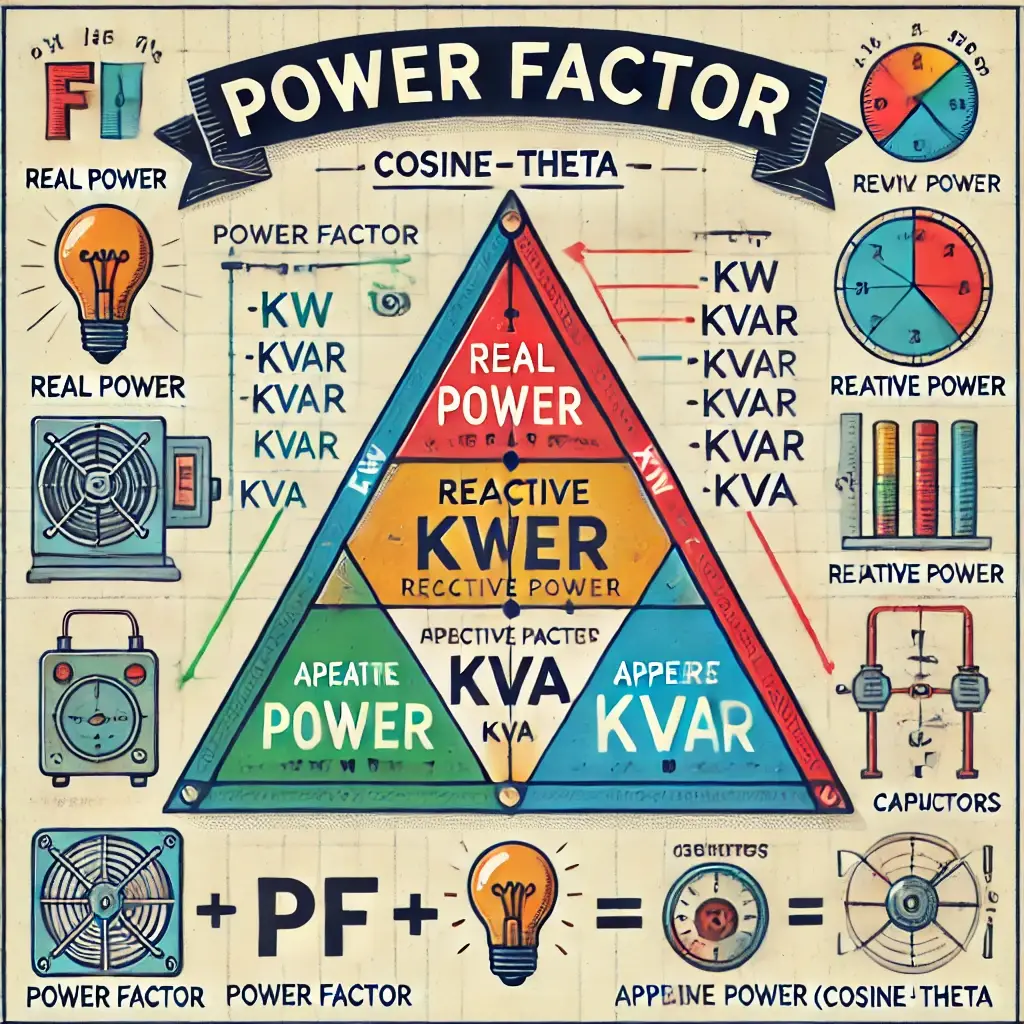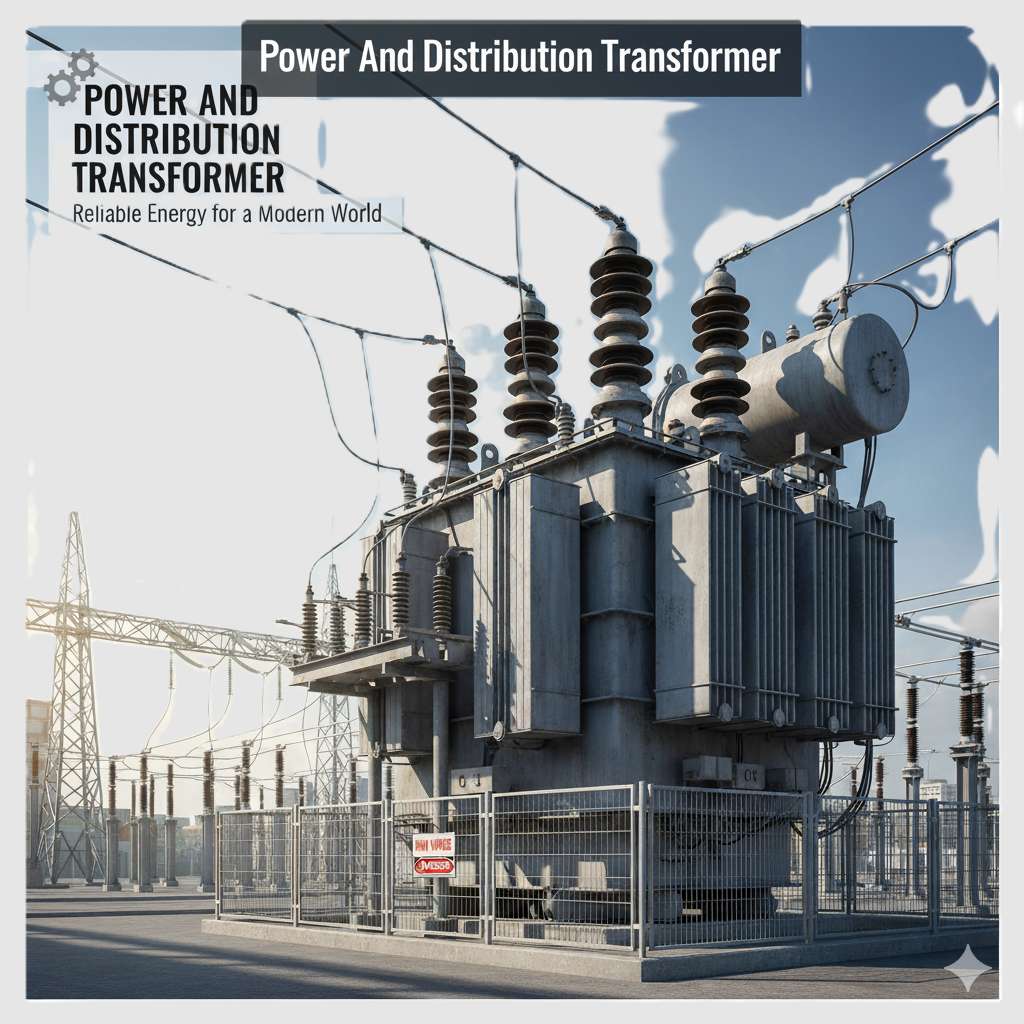What is a Circuit Breaker?
A circuit breaker essentially consists of fixed and moving contacts, called electrodes. Under
normal operating conditions, these contacts remain closed and will not open automatically until and
Unless the system becomes faulty.
The contacts can be opened manually or by remote control whenever desired. When a fault occurs on any
part of the system, the trip coils of the breaker get energized, and the moving contacts are pulled apart by
some mechanism, thus opening the circuit.
Table of Contents
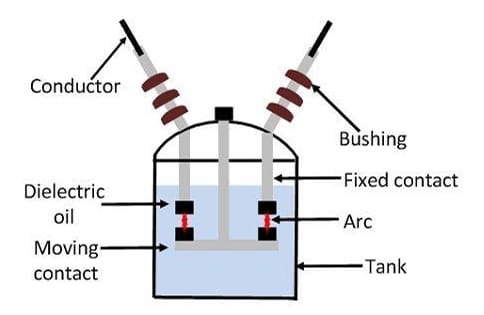
Operating principle of Circuit Breaker
When the contacts of a circuit breaker are separated under fault conditions, an arc is struck
between them. The current is thus able to continue until the discharge ceases. The production of arc not
only delays the current interruption process but it also generates enormous heat which may cause damage
to the system or to the breaker itself. Therefore, the main problem in a circuit breaker is to extinguish the
arc within the shortest possible time so that the heat generated by it may not reach a dangerous value.
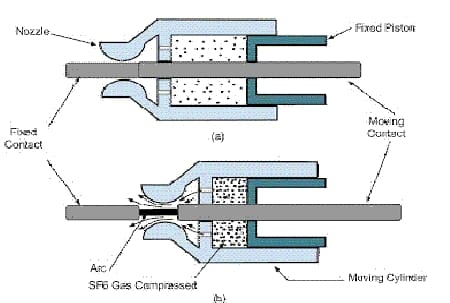
Arc Phenomenon in Circuit Breaker
When a short-circuit occurs, a heavy current flows through the contacts of the circuit
breaker before they are opened by the protective system. At the instant when the contacts begin to
separate the contact area decreases rapidly, and large fault current causes increased current density and
hence rise in temperature.
The heat produced in the medium between contacts (usually the medium is oil or air) is sufficient
to ionize the air or vaporize and ionize the oil. The ionized air or vapor acts as a conductor and an arc is
struck between the contacts. The potential difference between the contacts is quite small and is just
sufficient to maintain the arc. The arc provides a low resistance path and consequently the current in the
circuit remains uninterrupted so long as the arc persists.
- Degree of ionization – The arc resistance increases with the decrease in the number of ionized
particles between the contacts. - Length of the arc
- The arc resistance increases with the length of the arc, i.e. separation of
contacts.
- Cross-section of arc
- The arc resistance increases with the decrease in the area of a cross-section of
The arc.
METHODS OF ARC EXTINCTION
There are two methods of extinguishing the arc in circuit breakers
- High resistance method
- Low resistance or current zero method.
High Resistance Method In circuit breaker
In this method, arc resistance is made to increase with time so that the current is reduced to a value
insufficient to maintain the arc. Consequently, the current is interrupted or the arc is extinguished.
The principal disadvantage of this method is that enormous energy is dissipated in the arc. Therefore, it is
employed only in d.c. circuit breakers, Land low-capacity a.c. circuit breakers.
The resistance of the arc may be increased by
Lengthening the arc –
The resistance of the arc is directly proportional to its length. The length of
the arc can be increased by increasing the gap between contacts.
Cooling the arc –
Cooling helps in medium between the contacts. This increases the arc may be
obtained by a gas resistance. Efficient cooling blast directed along the arc.
Reducing cross-section of the arc –
If the area of cross-section of the arc is reduced, the voltage
necessary to maintain the arc is increased. In other words, the resistance of the arc path is
increased. The cross-section of the arc can be reduced by letting the arc pass through a narrow
opening or by having smaller area of contacts.
Splitting the arc
The resistance of the arc can be increased by splitting the arc into a number of
smaller arcs in series. Each one of these arcs experiences the effect of lengthening and cooling.
The arc may be split by introducing some conducting plates between the contacts.
Low Resistance or Current zero Method
This method is employed for arc extinction in AC Circuits only.
In this method, arc resistance is kept low until current zero where the arc extinguishes naturally and is
prevented from restriking inspire of the rising voltage across the contacts.
All modern high power AC Circuit Breakers employ this method for arc extinction
.
In an a.c. system, current drops to zero after every half-cycle. At every current zero, the arc extinguishes
for a brief moment.
Now the medium between the contacts contains ions and electrons so that it has small dielectric strength
and can be easily broken down by the rising contact voltage known as restriking voltage
.
If such a break-down does occur, the arc will persist for another half-cycle. If immediately after current
zero, the dielectric strength of the medium between contacts is built up more rapidly than the voltage
across the contacts, the arc fails to restrike and the current will be interrupted. The rapid increase of
dielectric strength of the medium near current zero can be achieved by
(a) Causing the ionised particles in the space between contacts to recombine into neutral molecules.
(b) Sweeping the ionized particles away and replacing them by unionized particles.
Therefore, the real problem in AC arc interruption is to rapidly deionize the medium between contacts as
soon as the current becomes zero so that the rising contact voltage or restriking voltage cannot breakdown
the space between contacts. The de-ionization of the medium can be achieved by :
Lengthening of the gap :(TYPES OF CIRCUIT BREAKER)
The dielectric strength of the medium is proportional to the length of the gap between contacts.
Therefore, by opening the contacts rapidly, higher dielectric strength of the medium can be achieved.
(ii) High pressure.
If the pressure in the vicinity of the arc is increased, the density of the particles constituting the’
Discharge also increases. The increased density of particles causes a higher rate of de-ionization, and
consequently, the dielectric strength of the medium between contacts is increased.
(iii) Cooling:
Natural combination of ionized particles takes place more rapidly if they are allowed to cool.
Therefore, dielectric strength of the medium between the contacts can be increased by cooling the arc.
(iv) Blast effect :
If the ionised particles between the contacts are swept away and replaced by un-ionized particles,
the dielectric strength of the medium can be increased considerably. This may be achieved by a gas
blast directed along the discharge or by forcing oil into the contact space.
Restriking voltage:
It may be defined as the voltage that appears across the breaking contact at the instant of arc
extinction.
Recovery voltage:
It may be defined as the voltage that appears across the breaker contact after the complete
removal of transient oscillations and final extinction of arc has resulted in all the poles.
Arc voltage:
It may be defined as the voltage that appears across the contact during the arcing period, when the
current flow is maintained in the form of an arc. It assumes low value except for the point at which the
voltage rise rapidly to a peak value and current reaches to zero.
The rate of Rise of Restriking Voltage
It is defined as the slope of the steepness tangent of the restriking voltage curve. It is expressed in
Kv/µs. RRRV is directly proportional to the natural frequency. The expression for the restriking voltage is
expressed as

The transient voltage vanishes rapidly due to the damping effect of system resistance, and the normal
frequency system voltage is established. This voltage across the breakers contact is called recovery
voltage.
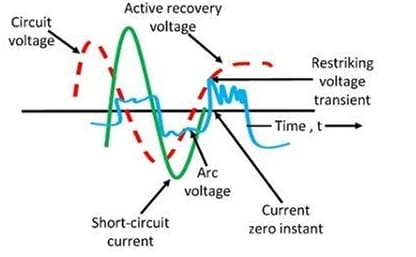
The waveforms of recovery and the restricting voltage are shown in the figure After the current zero,
the voltage appearing across the breaker contacts is composed of transient restriking voltage and power
frequency recovery voltage.
Current chopping
While interrupting a highly inductive current, like a no-load current of a transformer, the rapid
deionization of the contact space and blast effect may cause current interruption before its natural zero. Such
an interruption of current before its natural zero is termed “current chopping”. This phenomenon is
more pronounced in the case of air-blast circuit breakers, which exerts the same demonizing force for all
currents within its short-circuit capacity. Even though the instantaneous value of current being
interrupted may be less than the normal current rating of the breaker, it is quite dangerous from the point
of view of overvoltages, which may result in the system.
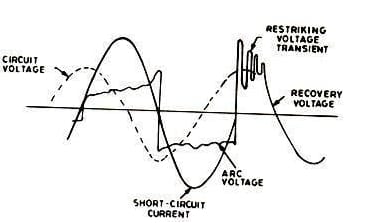
Let,
L = Inductance of the system
C = Capacitance of the system
i =Instantaneous value of arc current
V = Instantaneous value of capacitor voltage (which appears across the breaker when it opens)
1/2(Li²)=1/2(CV²)
V=i√(L/C)
Circuit Breaker Ratings(circuit breaker keeps tripping)
The rating of the circuit breaker is given according to the duties that are performed by it. For
complete specifications, standard rating, and various tests of switches and circuit breakers, IS 375/1951
may be consulted. A circuit breaker is required to perform the following three major duties.
It must be capable of opening the faulty circuit and breaking the fault current. This is described as
breaking capacity of a circuit breaker
- It must be capable of being closed on to a fault. This refers to making capacity of a circuit breaker
- It must be capable of carrying fault current for a short time while another circuit breaker is clearing the fault. This refers to short time capacity of the circuit breaker.
In addition to the above ratings, a circuit breaker should be specified in terms of
Rated voltage:
The rated maximum voltage of a circuit breaker is the highest RMS voltage, above nominal
system voltage, for which the circuit breaker is designed and is the upper limit for operation. The
rated voltage is expressed in kVrms and refers to the phase voltage for a phase circuit.
Rated current:
The rated normal current of a circuit breaker is the rms value of the current which the circuit
breaker shall be able to carry at rated frequency and at the rated voltage continuously, under
specified condition.
Rated frequency:
The rated frequency of a circuit breaker is the frequency at which it is designed to operate.
Operating Duty
The operating duty of a circuit breaker consists of the prescribed number of unit operations at
stated intervals.
Breaking capacity:
Breaking current is the RMS value of current that a circuit breaker is required to break at the
instant of contact separation. The symmetrical breaking current is the RMS value of its symmetrical
component. If, however, at the instant of contact separation, the wave is still asymmetrical, it is known as
the asymmetrical breaking current.
Breaking capacity (MVA) = Rated symmetrical breaking current (kA) × Rated service voltage (kV) × √3
Making capacity:
A circuit breaker may complete a full short circuit on being closed. This is known as making capacity.
Making capacity = 1.8 × √2 × Symmetrical breaking capacity.
Short time rating:
The circuit breaker should be capable of carrying high currents safely and without showing undue
stress for a specified short period in a closed position. This is known as a short-time rating.
This happens in case of momentary fault, like a bird age on the transmission lines, and the fault is
automatically cleared and persists only for 1 or 2 seconds. For this reason, the circuit breakers are short-time rated and they trip only when the fault persists for a duration longer than the specified time limit.
I am an Electrical Engineer with qualifications in ITI, Diploma, and B.Tech. I have worked as an ITI college instructor for 3 years and have over 5 years of hands-on experience in the electrical field. The information shared on this website is based on trusted electrical engineering textbooks such as P.S. Bimbhra, B.L. Theraja, V.K. Mehta, and real-world practical experience.

